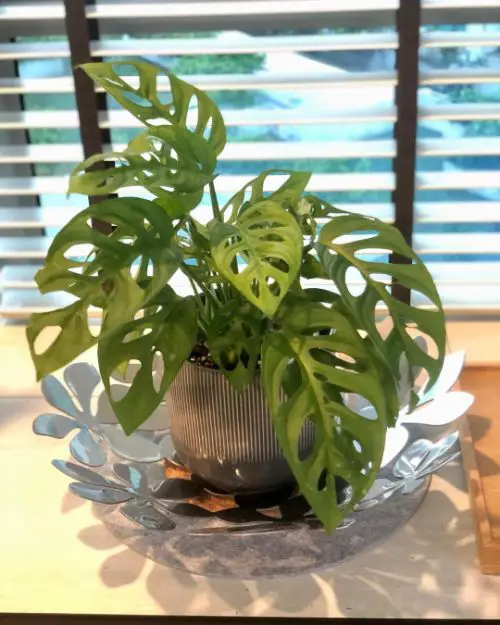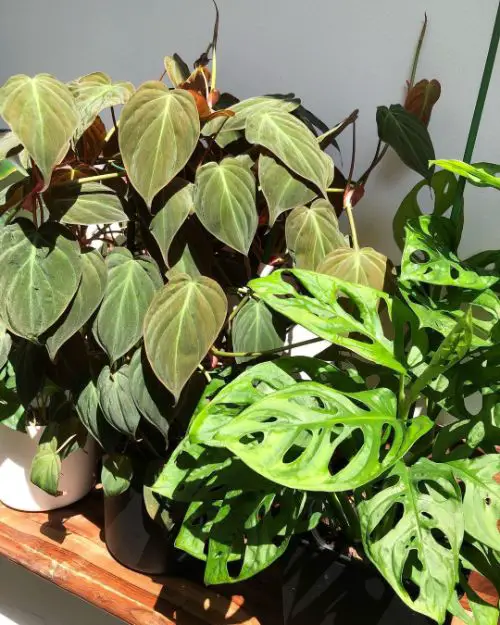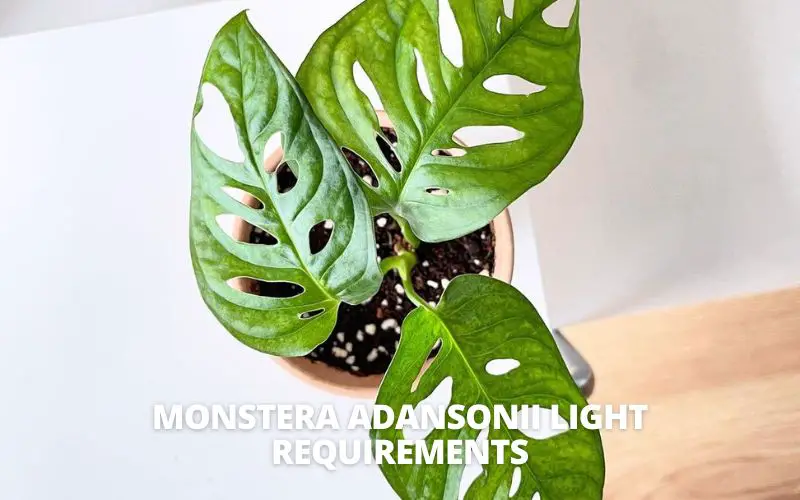Do you have a Monstera adansonii plant at home? If so, then you may be wondering about Monstera adansonii light This can be a tricky question to answer, as different plants will require different amounts of light. In this blog post, we will discuss the Monstera Adansonii light requirements for plants and provide some tips on how to best meet their needs!
Monstera Adansonii light requirements
Monstera Adansonii light requirements can vary depending on the plant. Some monstera Adansonii plants will do well in low-light conditions, while others may need more light.
1. Bright, indirect light
Indirect light is best for Monstera Adansonii plants. If you live in a colder climate, you may need to provide additional lighting for your plant with grow lights or fluorescent bulbs.

You can check the light intensity your Monstera is receiving in a specific area to see if it meets its light needs in one of several ways:
Use a Light Meter
All the work will be done for you by these useful tools. Photographers frequently use light meters to gauge the quantity of light in a given space. In general, foot candles are used to evaluate light intensity.
The University of Florida states that low light conditions are between 25 and 100-foot candles, medium light is between 100 and 500-foot candles, and high light is between 500 and 1000-foot candles. Direct sunlight is a rating of more than 1000-foot candles.
Monsteras prefer light intensities between 100 and 500-foot candles, while some species can tolerate lower or greater levels.
Use the Shadow Test
This process is quick and simple and only needs your hands and no additional tools.
Your Monstera Adansonii plant and the source of light should be around 12 inches apart from each other. Spread your fingers.
Watch the shadow your hand makes. Your Monstera plant is likely to flourish in this position if the shadow is light in color and has fuzzy edges. The presence of dense shadows with distinct boundaries suggests that the light is too strong for your Monstera. Similarly, a very small or nonexistent shadow indicates low light levels, which may be too gloomy for your Monstera plant.
Look for a spot that produces a light-colored shadow with fuzzy or rounded edges.
2. Window placement
The amount of light your Monstera receives can be estimated using the position of your windows as a guide. However, keep in mind that seasonal changes can affect how bright it is. The light coming through your windows will be dimmer during the fall and winter months in the Northern Hemisphere since the sun is lower in the sky.
- Northern windows: Without any direct sunshine, soft light comes from northern windows. Usually, they work well for plants that like low to medium light. If you want your Monstera adansonii plant to benefit from the light from a northern window, it will probably need to be placed close to the window.
- Eastern windows: Although the early sun shines brightly through eastern windows, the rays are benign and usually do not burn your Monstera or boil the foliage of your plants. Your Monstera plant will likely be able to withstand some direct sunlight from an eastern window and will appreciate the lingering light throughout the day.
- Southern windows: For the majority of the day, southern windows receive a lot of sunlight. Unless your Monstera adansonii is protected from the sun by trees or other structures, the sunlight near the window is probably too strong for it. However, your Monstera plant will flourish if it is positioned a few feet away from the window and given shade (such as sheer curtains) from the sun.
- Western windows: The afternoon sun shines brightly through western windows, especially in the summer. Placing your Monstera adansonii close to a western window is a recipe for catastrophe, even though a room with a western window may offer fantastic light for a Monstera situated across the room.
Place your Monstera plant out of direct sunlight or use transparent drapes to absorb the sun’s rays if you are growing it in a room with a western window.

How much light does Monstera adansonii need?
The Monstera adansonii, or Swiss cheese plant, is a popular houseplant that is known for its large, perforated leaves. While it prefers bright, indirect light, it can also tolerate low-light conditions.
However, if the light is too low, the leaves may become faded or begin to drop. The best way to determine how much light yourMonstera needs is to observe the leaves. If they are vibrant and green, the plant is getting enough light. If the leaves are yellow or brown, the plant may be getting too much light. If the plant is not getting enough light, its growth will be stunted and its leaves will be small.
You can also like: Monstera Growth Stages: From Seedling to Mature Plant
5 Signs Monstera Adansonii needs more light
If you notice any of the following signs, your Monstera Adansonii plant may need more light:
- The leaves are starting to yellow
- The plant is not growing as quickly as it should be
- The plant seems to be struggling to bloom or produce new leaves
- The plant looks overall unhealthy
- The plant has leggy stems and vines
If you think your Monstera Adansonii plant needs more light, try moving it to a brighter location. If you live in a colder climate, you may need to provide additional lighting for your plant with grow lights or fluorescent bulbs. Monstera Adansonii will thrive and bring beauty to your home for years to come.
How to measure the light conditions of your Monstera adansonii
The light requirements of your Monstera Adansonii will depend on the size and age of your plant. If you have a young plant, it will need more light than an older plant. The easiest way to measure the light conditions in your home is to use a light meter. You can purchase a light meter at most hardware stores.
Once you have your light meter, take a reading in the spot where you plan to put your Monstera Adansonii. The ideal range for a Monstera Adansonii is between 500 and 700 lux. If the reading is below 500 lux, your plant will need more light. If the reading is above 700 lux, your plant will need less light. You can also use a bright white LED bulb to provide additional light for your plant if needed.

Can Monstea Adansonii grow in low light?
Yes, Monstea Adansonii can grow in low light. This plant is native to shady rainforests, so it is well-adapted to low-light conditions. In fact, Monstea Adansonii will often flower best when grown in indirect or filtered light. However, too much shade can cause the leaves to become etiolated, or stretched out. If this happens, simply move the plant to a brighter spot. Monstea Adansonii is a versatile plant that can thrive in a range of lighting conditions.
The benefits of providing the right amount of light for your Monstera adansonii
There are many benefits to providing the right amount of light for your Monstera Adansonii plant. Some of these benefits include:
- Improved growth
- Healthier leaves
- More flowers and fruit
- Better overall health
If you provide the right amount of light for your Monstera Adansonii plant, you can expect it to grow quickly and be healthy. Additionally, the plant will be more likely to bloom and produce new leaves.
Thanks for reading! Monstera Adansonii light requirements can be tricky, but by following these tips, you can make sure that your plant gets the light it needs.


